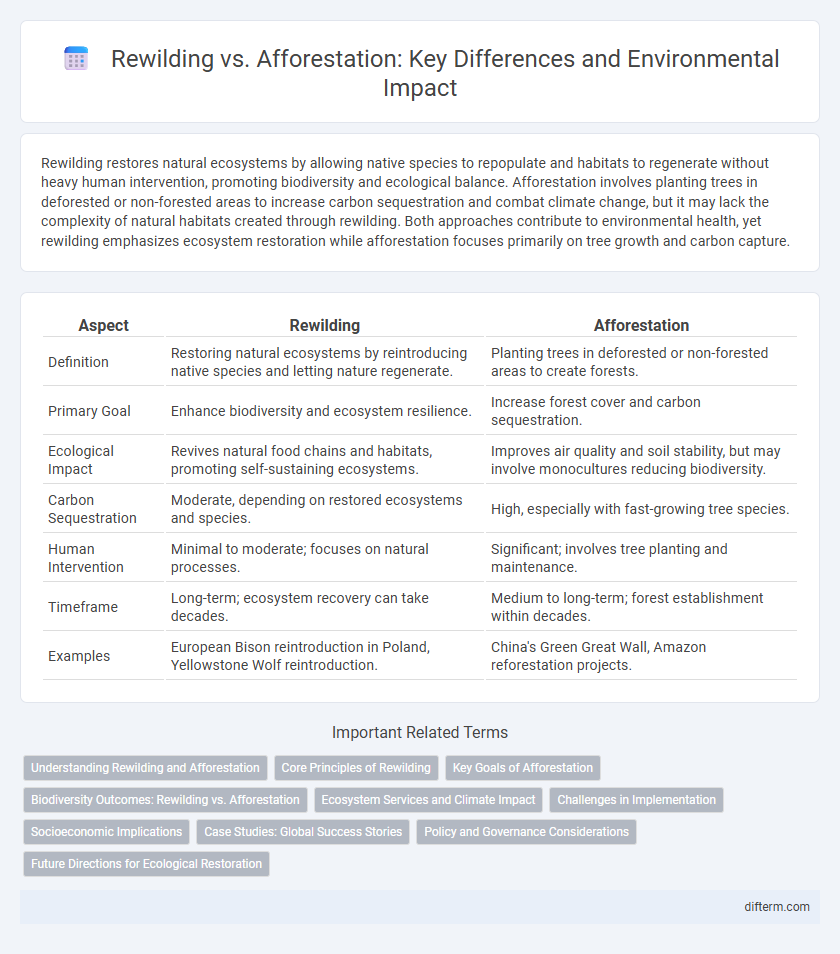Rewilding restores natural ecosystems by allowing native species to repopulate and habitats to regenerate without heavy human intervention, promoting biodiversity and ecological balance. Afforestation involves planting trees in deforested or non-forested areas to increase carbon sequestration and combat climate change, but it may lack the complexity of natural habitats created through rewilding. Both approaches contribute to environmental health, yet rewilding emphasizes ecosystem restoration while afforestation focuses primarily on tree growth and carbon capture.
Table of Comparison
| Aspect | Rewilding | Afforestation |
|---|---|---|
| Definition | Restoring natural ecosystems by reintroducing native species and letting nature regenerate. | Planting trees in deforested or non-forested areas to create forests. |
| Primary Goal | Enhance biodiversity and ecosystem resilience. | Increase forest cover and carbon sequestration. |
| Ecological Impact | Revives natural food chains and habitats, promoting self-sustaining ecosystems. | Improves air quality and soil stability, but may involve monocultures reducing biodiversity. |
| Carbon Sequestration | Moderate, depending on restored ecosystems and species. | High, especially with fast-growing tree species. |
| Human Intervention | Minimal to moderate; focuses on natural processes. | Significant; involves tree planting and maintenance. |
| Timeframe | Long-term; ecosystem recovery can take decades. | Medium to long-term; forest establishment within decades. |
| Examples | European Bison reintroduction in Poland, Yellowstone Wolf reintroduction. | China's Green Great Wall, Amazon reforestation projects. |
Understanding Rewilding and Afforestation
Rewilding involves restoring ecosystems by reintroducing native species and allowing natural processes to shape the landscape, enhancing biodiversity and ecological resilience. Afforestation focuses on planting trees on non-forested lands to increase forest cover, sequester carbon, and mitigate climate change. Both strategies contribute to environmental restoration but differ in approach, with rewilding emphasizing ecological dynamics and afforestation prioritizing tree establishment.
Core Principles of Rewilding
Rewilding centers on restoring natural processes and native species to promote self-sustaining ecosystems, emphasizing minimal human intervention and ecological connectivity. Core principles include allowing natural succession, reintroducing keystone species, and enhancing biodiversity to revive ecosystem functions. Unlike afforestation, which primarily involves planting trees, rewilding prioritizes dynamic habitats that support complex wildlife communities and resilience.
Key Goals of Afforestation
Afforestation primarily aims to increase forest cover to combat climate change by enhancing carbon sequestration and restoring biodiversity in degraded areas. It supports soil conservation and improves water cycles, contributing to ecosystem stability and resilience. By establishing new forests, afforestation helps create habitats for wildlife and promotes long-term environmental sustainability.
Biodiversity Outcomes: Rewilding vs. Afforestation
Rewilding enhances biodiversity by restoring natural processes and native species, creating self-sustaining ecosystems that support diverse flora and fauna. Afforestation can increase habitat area but often involves monocultures that provide limited ecological niches, reducing overall biodiversity compared to rewilded landscapes. Studies show rewilded sites exhibit higher species richness and functional diversity, promoting ecosystem resilience and adaptive capacity in the face of climate change.
Ecosystem Services and Climate Impact
Rewilding enhances ecosystem services by restoring natural processes, increasing biodiversity, and improving carbon sequestration through the revival of native species and habitats, which stabilizes local climates and supports soil health. Afforestation contributes to climate impact mitigation by establishing new forested areas that capture atmospheric carbon dioxide, but may offer limited biodiversity benefits if monoculture plantations are used. Combining rewilding with afforestation strategies maximizes carbon storage while promoting resilient ecosystems that better regulate hydrological cycles and support diverse wildlife.
Challenges in Implementation
Rewilding faces challenges such as balancing ecosystem restoration with human land use and managing unpredictable species reintroductions. Afforestation encounters difficulties including selecting appropriate tree species for climate resilience and minimizing negative impacts on local biodiversity. Both strategies require long-term monitoring and community engagement to ensure sustainable environmental benefits.
Socioeconomic Implications
Rewilding enhances biodiversity and ecosystem services, often leading to increased tourism revenue and job creation in rural communities, while maintaining cultural heritage and traditional land use practices. Afforestation projects can boost carbon sequestration and timber production, contributing to economic growth but may displace local communities and alter land ownership patterns. Both approaches require careful socioeconomic assessments to balance ecological benefits with community livelihoods and social equity.
Case Studies: Global Success Stories
Case studies from around the world demonstrate the efficacy of rewilding and afforestation in restoring biodiversity and enhancing ecosystem resilience. In the Scottish Highlands, rewilding projects have successfully reintroduced native species and expanded natural habitats, boosting carbon sequestration and wildlife populations. Brazil's afforestation efforts in the Atlantic Forest have reversed deforestation trends, contributing significantly to regional climate regulation and habitat connectivity.
Policy and Governance Considerations
Effective policy and governance frameworks are crucial for balancing rewilding and afforestation initiatives, ensuring ecological integrity and socio-economic benefits. Rewilding policies prioritize restoring natural processes and biodiversity, demanding adaptive management and community participation, while afforestation requires regulatory standards for species selection, land use, and carbon accounting. Integrating cross-sectoral governance with transparent monitoring mechanisms can maximize environmental resilience and climate mitigation outcomes.
Future Directions for Ecological Restoration
Future directions for ecological restoration emphasize integrating rewilding with afforestation to enhance biodiversity and ecosystem resilience. Rewilding promotes the return of native species and natural processes, while afforestation focuses on planting trees to sequester carbon and restore habitats. Combining these approaches can optimize landscape connectivity, support climate adaptation, and improve ecosystem services.
rewilding vs afforestation Infographic

 difterm.com
difterm.com